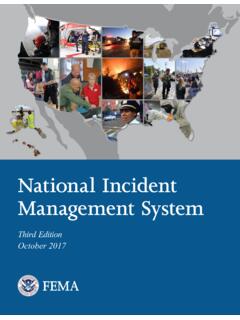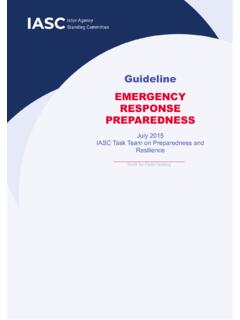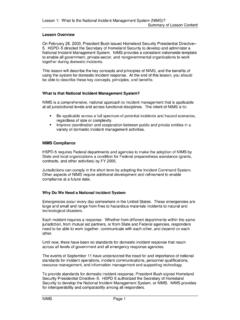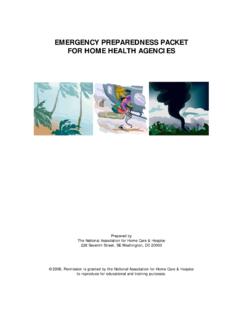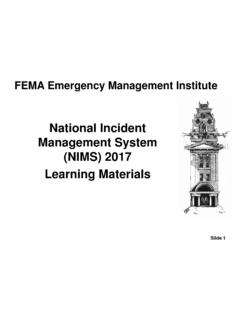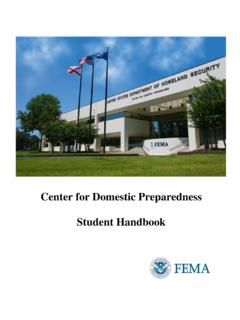Transcription of Nuclear Emergency Planning and Response Guidance
1 Nuclear Emergency Planning and Response Guidance Part 1 preparedness October 2015. NNEPRG preparedness Crown copyright 2015. URN 15D/465. You may re-use this information (not including logos) free of charge in any format or medium, under the terms of the Open Government Licence. To view this licence, visit or write to the Information Policy Team, The national Archives, Kew, London TW9 4DU, or email: Any enquiries regarding this publication should be sent to us at Contents 1. Introduction .. 5. Purpose and structure of this Guidance .. 5. Context - civil contingencies Planning .. 6. Why and how Nuclear EP is different .. 6. Legislative Context .. 7. 2. Understanding Nuclear Risk.
2 8. Summary .. 8. Nuclear 8. The likelihood of radiation emergencies in the UK .. 8. The scale of radiation emergencies to be considered by planners .. 9. The possible impacts of a radiation Emergency .. 10. Stress-related health impacts .. 10. Radiation health impacts .. 11. Radiation Exposure Pathways in an Emergency .. 12. Countermeasures to Reduce Radiation Exposure in an Emergency .. 12. The role of Emergency Reference Levels in risk reduction .. 13. The importance of delivering a co-ordinated Response .. 15. Different time phases in a radiation 16. Acute / Response Phase (see frames 1A and 1B in Figure 1) .. 17. Countermeasures during the Acute / Response Phase of an 18.
3 Longer term countermeasures phase (see frame 2 in Figure 1) .. 19. The Recovery Phase .. 21. 3. Emergency Planning .. 22. Summary .. 22. Introduction to Emergency Response Planning .. 22. Emergency Response Planning : REPPIR Requirements .. 23. Emergency Response Planning : Objectives .. 23. Emergency Response Planning : Features and Content .. 24. Extendibility Assessment: Introduction .. 25. 4. Testing of Off-Site Plans .. 28. Summary .. 28. Introduction .. 28. Programming Level 2 and Level 3 Exercises .. 29. Planning .. 29. Scope and Duration of the Exercise .. 30. Exercise Conduct .. 31. Exercise 32. Debriefing following the Exercise .. 32. The Exercise Report.
4 33. Monitoring the 33. Cost Recovery .. 33. 5. Testing of Recovery Plans .. 34. Introduction .. 34. Setting exercise objectives .. 35. Exercise Format .. 36. Developing the Nuclear recovery scenario .. 36. Developing the materials to manage the Nuclear recovery event .. 38. Developing a driving script .. 39. 1. Introduction Purpose and structure of this Guidance The Radiation ( Emergency preparedness and Public Information) Regulations 2001. (REPPIR) and the supporting Guidance aim to establish a framework for the protection of the public through Emergency preparedness for radiation Emergency with the potential to affect members of the public, from premises and specified transport operations.
5 The UK Concept of Operations (ConOps) for Nuclear emergencies at fixed sites recognises that from the outset the Response to a radiation Emergency will require both a local and a national Response , with the two being fully integrated. This Guidance provides the context within which planners and responders need to approach radiation emergencies. The document is structured into three parts Part 1: preparedness , Part 2: Response and Part 3: Recovery. In addition, the Concept of Operations provides high level direction from the outset. Concept of Operations The Nuclear Site Emergency Response Concept of Operations 2015 provides high level Guidance on strategic objectives and how local and national responders will co-ordinate their activities.
6 Setting and communicating clear, unambiguous and achievable strategic objectives in Planning , Response and recovery is a priority as these should form the basis for shaping and guiding plans. Part 1 preparedness Part 1 describes how to prepare for responding to Nuclear emergencies. It is aimed at those who are responsible for drawing up Nuclear Emergency plans or who may be involved in their implementation, either in exercises or a real Emergency . Part 2 Response Part 2 describes what Nuclear Emergency responders should consider in order to deliver an effective and nationally consistent Response to any radiation Emergency at a Nuclear site. It outlines what needs to be covered in Response activity but does not specify how it is to be done in other than general detail because the local arrangements will vary in some measure from place to place subject to the nature and dispersal of resources that will be required to deploy an effective Response .
7 Flexibility will be the governing factor when dealing with complex and time critical issues at the local level of Response . Part 2 brings together Response Guidance from previous iterations of the NEPLG. Consolidated Guidance with good practice from local on-site and off-site Emergency arrangements and from wider national Emergency Response arrangements including learning from the Civil Contingencies Act 2004 (CCA) and more recent Emergency services Joint Working doctrine. It is consistent with the Emergency Response duties and associated Guidance set-out in the CCA, Devolved Administration Guidance and industry specific regulatory requirements covered by REPPIR and the Nuclear Installations Act 1965.
8 5. NNEPRG - preparedness Part 3 Recovery Part 3 describes the process by which areas affected by the Emergency can return to a state that community representatives and stakeholders have determined acceptable and enables a return to a lifestyle where the incident is no longer a dominant influence Context - civil contingencies Planning The CCA, and accompanying non-legislative measures (collectively referred to as the CCA Regulations), delivers a single framework for civil protection in the United Kingdom. Emergency Response arrangements in the UK under the CCA regulations, including in Scotland which has its own Guidance (Preparing Scotland, 2012), are now well established and provide a solid basis for responding to any radiation Emergency .
9 This Guidance provides the context within which planners and responders need to approach Nuclear emergencies. All civil Nuclear licensed Nuclear sites in the UK are required by the Office for Nuclear Regulation (ONR) to provide a safety case. The safety case provides information on both the likelihood of radiation emergencies and the potential scale of radioactive releases in the event they were ever to occur, which in turn informs Emergency Planning , Response and recovery. Why and how Nuclear EP is different Planning for radiation emergencies has much in common with other potential hazards. However these types of Emergency have some features that do need special consideration.
10 These are highlighted in this Guidance . The effectiveness of Nuclear Emergency plans is not determined by their ability to eliminate totally any additional radiation exposure but is instead measured by their ability to reduce by quite small amounts any additional lifetime risk of cancer. Moreover the plans must achieve this without causing other detriments to those affected people that could outweigh these relatively modest reductions in lifetime risk. Research into radiation emergencies has identified that one important driver of these types of health impacts is a higher than justified level of anxiety and concern among the public. This is exemplified by: People not at any significant risk believing they or their loved ones have in fact been exposed to harmful radiation.










